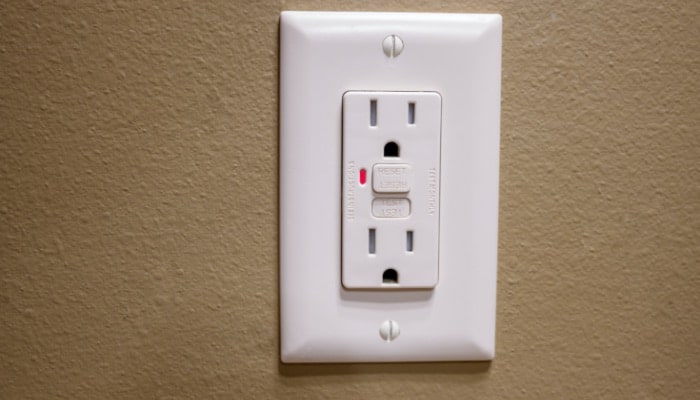
GFCI Outlets
Do you know if you have Ground Fault Circuit Interrupter (GFCI) protected outlets in your home? These are the devices that generally look a little bit different than normal power outlets or receptacles; they’re usually square and have “test” and “reset” buttons on them. Some may have a small sticker that reads: GFCI protected outlet. These funny little outlets (not the stickers) save lives. The GFCIs also have the capacity to protect other “normal” outlets on the same circuit, so they can save lives too.
GFCIs are designed to sense water and moisture and completely shut down the flow of electrical current. This is why they are required in parts of your home where water will, inevitably, come in contact with the outlet and create a shock hazard. GFCIs are required by the National Electrical Code (NEC) in Kitchens, Wet Bars, Bathrooms, Garages, Crawlspaces, Unfinished Basements, Outside, near Pools and Spas, and a few other places. This is because water is a natural conduit for electricity and creates a shortcut or “bridge” for the electrical current to leap from an outlet and into a person! The bridge can be created with wet hands, wet surfaces, and even an extension cord that is touching water.
Another reason that GFCIs are required outside, in garages, unfinished basements, and crawlspaces is that concrete and dirt are conductors of electricity too, even when they’re not wet. (Who knew?)
Because these quick-acting devices instantly shut down when needed, hundreds of people are spared every year from being shocked or killed. But they only help you if you have them . . . and if they were installed correctly in the first place (usually by a licensed and certified electrician) and are still in good working order. (Nit-picky details, really.)
The NEC continuously ups their standards for GFCI requirements in new homes (and when upgrading an electrical system or remodeling). But all too many homes were built prior to when GFCIs were required anywhere. This includes homes that haven’t been updated since 1973, when the code first called for GFCI protection (for exterior outlets only), or since multiple updates in years after that (1975, 1978, 1987, 1990, 1993, and 2005). We’ve come a long way! Before you think, “oh, that’s just electrical mumbo-jumbo,” remember, codes and standards usually are updated after a series of preventable accidents and deaths, not before.
If you’re not sure whether your outlets are GFCI protected, have a TE Certified Electrician take a look! We also include GFCIs on our Whole House Electrical Safety & Fire Inspections reports. If a home doesn’t pass muster in the area of GFCIs, there’s a good chance it’s not up to par in other areas too. (Better to know!) Your electrician can also make sure your exterior GFCI outlets are Weather Resistant rated and are properly protected with a “bubble” cover. If you want to check yourself, just look for a protective covering and “WR” stamped on the front of your outside outlets.
Did you have several GFCI outlets stop working at once? You may have a tripped GFCI somewhere in the house. This is common with
overloading (hair dryers, space heaters) or using equipment that has a ground fault in it. The GFCI shuts off the circuit because it’s not safe. And since the outlets are all generally on the same circuit, several throughout the house may be affected. It’s time to find the “reset” button on one of the GFCIs and “fix” all of them at once! Caveat: If a GFCI trips repeatedly, it is time to call a TE Certified Electrician!
Call us to fix it right. Get it done today. Call us, and we will have a certified electrician in a fully stocked truck at your door. We will provide an upfront price and do the work right then. No waiting. (770) 217-7527





